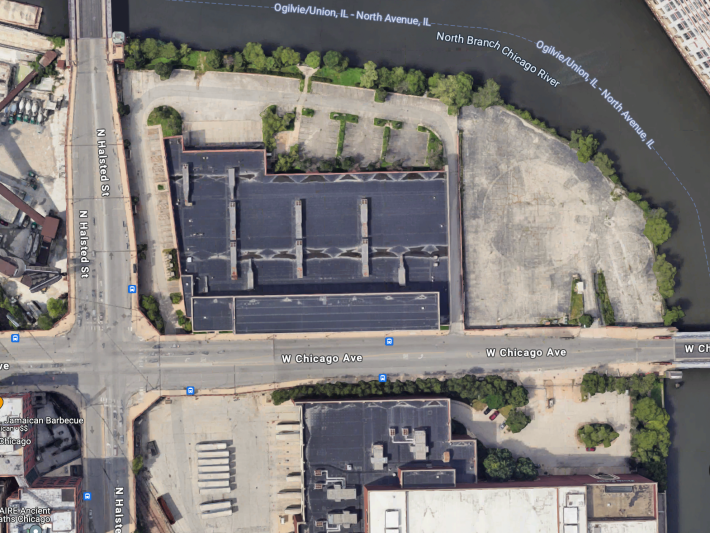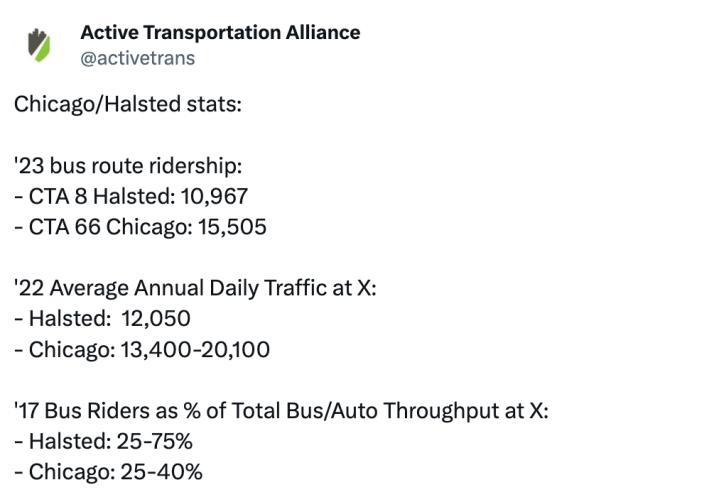
Bus and bike boosters are up in arms about the Chicago Department of Transportation's plans for widening Chicago Avenue at Halsted Street, the future site of Bally's Casino. The proposal was discussed at the meeting on CDOT's Chicago Avenue River Bridge and Chicago Avenue / Halsted Street Viaduct project, last night at Eckhart Park fieldhouse, 1330 W. Chicago Ave.

Back in 2018, the City of Chicago removed the existing 1914 movable bridge and installed the current bridge as a temporary structure until a more permanent bridge could be built. Chicago Avenue has traditionally been a major corridor, and the CTA's 66 Chicago route is one of the city's busiest bus lines. After the temporary bridge was put in, the City agreed to allow Bally's Corporation to build Chicago's first legal casino at the former site of the Tribune Publishing printing plant. The gambling facility is expected to further add to the traffic volume in the area.

Last night's meeting presented plans not only for the Chicago Avenue bridge, but for the Halsted Street viaduct immediately north of Chicago Avenue. The plan calls for a wider, four-lane bridge (up from the temporary bridge's three lanes) with access to the riverwalk, and turning Chicago Avenue's westbound lane into a right-turn / bus lane just east of Halsted. On Halsted, CDOT plans to add bike lanes and put in a northbound bus lane south of Chicago Avenue.

Near the end of the meeting comments from attendees suggested that many residents feel the proposed transit improvements are, at best, half-measures, especially given the residential development planned for the area.
CDOT is widening the Chicago bridge, adding lanes of traffic.
— Lincoln Ave Bike Lane (@lincolnavebike) January 24, 2024
The 66 bus has the second highest ridership in Chicago. At times it represents 50% of people moving through here.
It’s getting crumbs from @ChicagoDOT pic.twitter.com/7ScFIRBI7d
According to the CDOT handout, the project is currently in design phase, but it has a pretty aggressive timeline. The City hopes to complete engineering by the end of spring 2024, with the goal of starting construction this summer and completing it by the end of 2026.
The Chicago/Halsted intersection is tricky because both streets are raised. Halsted crosses over the freight-only Union Pacific Railroad tracks that historically served businesses along the west shore of the Chicago River, including the aforementioned Tribune plant. According to CDOT, the Halsted Street viaduct is over 50 years old and is overdue for a rehab.
.According to the meeting materials, the new Chicago Avenue bridge will have four lanes, with two in each direction. The structure will be a tied arch bridge that can be raised using a jacking system (think a more modern version of the Canal Street railroad bridge). The plan also mentions a "Riverwalk connection," which would make it easier to reach the casino on foot. Right now, there is no way to get from Chicago Avenue down to river level. The plan describes the bridge's wider dimensions as a way to "increase roadway capacity over the river."
Ever noticed how comfy it is for cyclists on Roosevelt W. of State, a fast multi-lane street, to ride on a bike lane between through lanes and a turn lane at Clark? Me neither.
— John Greenfield (@greenfieldjohn) January 24, 2024
.@ChicagoDOT thinks this a good idea at Chicago/Halsted, future Bally's site.https://t.co/NMjqXjZv5y pic.twitter.com/kUk60q3KjQ
The proposal doesn't call for any bus lanes on the bridge. But west of the bridge, Chicago Avenue widens to six lanes, and the plan calls for making the northernmost westbound lane a right turn / bus lane – in other words, drivers will only be able to use it if they're turning north on Halsted. It also mentions a bus queue jump, which will let westbound buses get around traffic. Much of Chicago Avenue east of the bridge already has (rarely enforced) bus lanes in both directions.

For Halsted, the plan calls for raised bike lanes on both sides of the street between Chicago Avenue and roughly where Ancona Street (630 N.) would be, while putting in a partial southbound bike lane and a northbound bike lane along the sidewalk north of the intersection. It also calls for putting in a northbound bus lane south of the intersection, roughly between Ancona and Huron streets. This would leave four lanes, two in each direction, available for drivers. The renderings suggest that the concrete median south of the intersection will be removed.

Several residents argued that putting in just one bus lane was a half-measure, especially on Halsted Street. There were also some concerns about whether the bus lanes would be enforced. Camera enforcement of bus lanes is not currently legal in Illinois, and state legislation would be needed to allow it.
After the meeting, the Active Transportation Alliance and several transit advocates echoed those concerns, while also raising concern about how a wider bridge would impact traffic without helping the buses.

Did you appreciate this post? Please consider making a tax-deductible donation.




